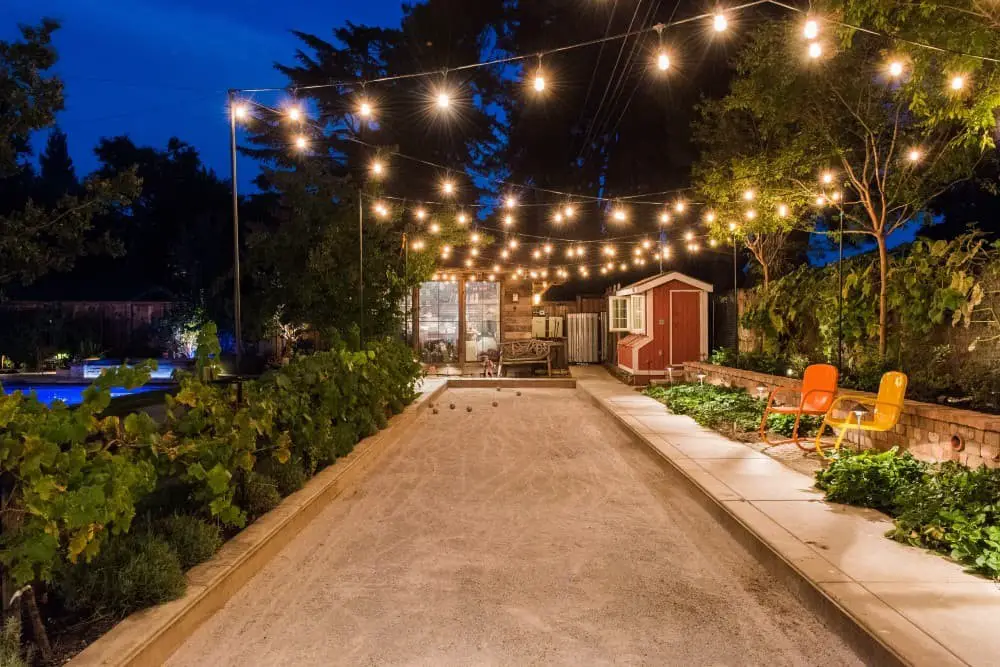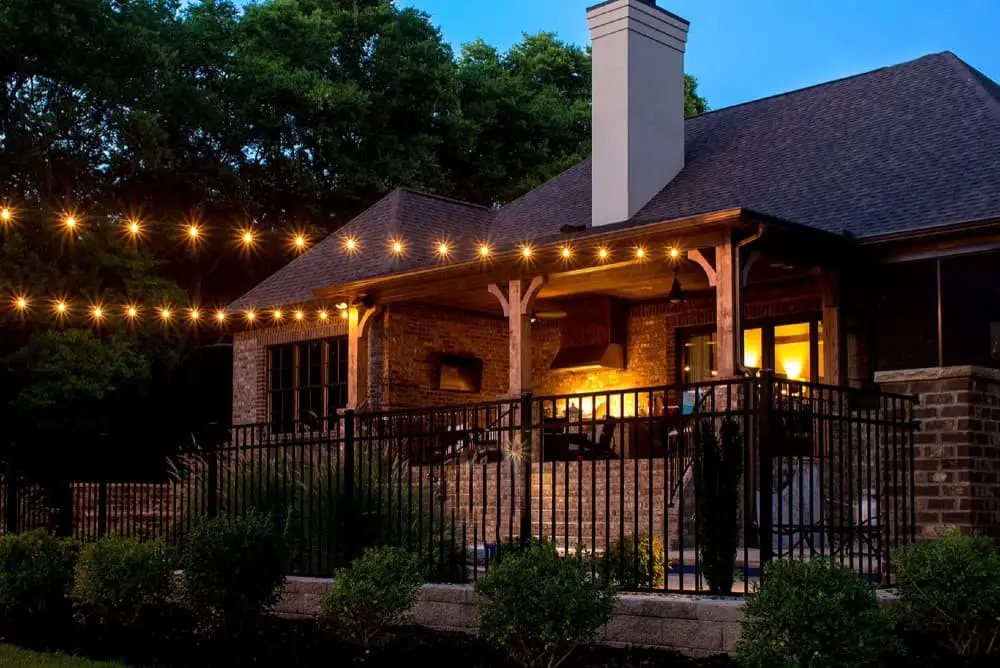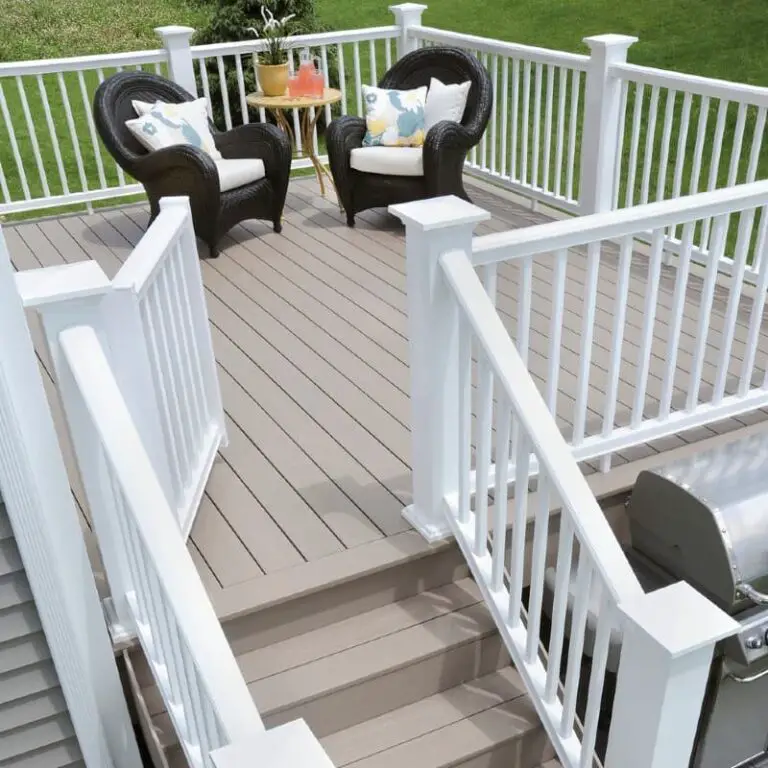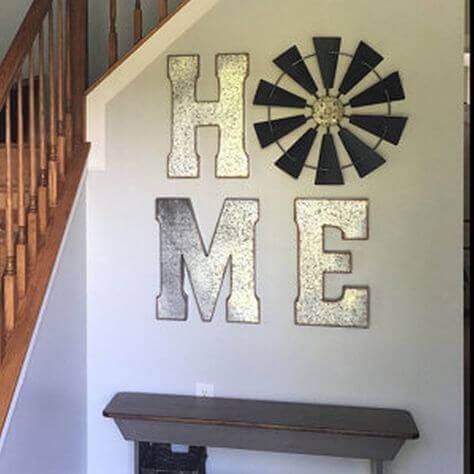15 Best Backyard String Light Ideas And Designs (With Pictures)
As the sun shines brightly and the temperature rises, there’s no better way to make the most of your summer than by transforming your backyard into an enchanting oasis. One simple yet effective way to achieve this is by adorning your outdoor space with vibrant string lights. In this article, we’ll delve into 15 captivating backyard string light ideas that will transport you to a world of magic and wonder.
Whether you’re seeking whimsical, romantic, or elegant lighting solutions, our comprehensive guide has got you covered. So gather your loved ones, get inspired, and let’s illuminate those summer nights! This article will cover an array of practical tips and creative ways to hang string lights in your backyard, including ideas for stringing them over a pole, using freestanding poles, shepherd’s hooks, and more.
Additionally, we’ll address common concerns such as the cost of installation, optimal heights, and clever methods for securing lights on concrete, patios, or without clips.
Backyard string light pole ideas.



When it comes to outdoor entertainment, string lights are an essential component. Not only do they provide ambiance and illumination for your backyard, but they can also be used to create a focal point or highlight specific features of your yard.
One popular way to utilize string lights is by wrapping them around a backyard pole. This approach eliminates the need for extension cords and exposed wires, making it a convenient and safe option.
If you’re looking for creative ways to use string lights, consider the following ideas:
Wrap them around a metal pole or pipe – This creates a unique look that draws attention to the lights. You can wrap the lights around a metal pole or a piece of pipe to achieve this effect.
Use them to accentuate architecture – If your backyard features an outdoor fireplace, gazebo, or other architectural elements, string lights can be used to highlight these features.
Wrap the lights around the structure and enjoy the added ambiance and illumination.
Create a focal point – Use string lights to draw attention to a water feature, fire pit, or other backyard attraction. Wrapping the lights around the feature creates a visually appealing display that adds interest to your outdoor space.
Wrap them around trees – If you have trees in your yard, wrapping string lights around their branches can create a magical and enchanting ambiance.
This approach eliminates the need for extension cords or exposed wires, making it a safe and convenient option.
Use them on decks and patios – String lights can be used to add warmth and ambiance to your deck or patio. Wrap the lights around the perimeter of the space to create a cozy and inviting atmosphere.
Backyard string light post ideas.


Transform your outdoor space into a cozy retreat by repurposing old materials into unique string light posts. Consider upcycling pallets or fence boards to create a rustic, weathered look that adds charm to your backyard. Alternatively, breathe new life into an old lamp post or create a budget-friendly option using PVC pipe. For a beachy vibe, wrap rope around the post and add some nautical flair. If you want to make a statement, try using colorful materials like fabric or yarn.
Keep things simple with a classic black and white design or go for a whimsical touch by shaping your string light post into an animal. For a more industrial look, use metal pipes and fittings to create a modern aesthetic. And for a romantic ambiance, wrap flowers or greenery around the post to create a beautiful, rustic focal point.
How do I string lights over my backyard?
When it comes to decorating your backyard with string lights, there are several factors to think about. First and foremost, you’ll need to decide which type of lights to use. With so many options available, from solar-powered to electrically charged, choosing the right ones for your needs is crucial. Additionally, consider how you’ll power them – will it be a rechargeable battery or a direct electrical connection? Once you’ve settled on the type of lights, think about their length and placement.
Measure out the area you want to illuminate to determine the ideal string length, taking into account the size of your yard and the number of lights you plan to use. Finally, decide where you’ll place the lights – along a fence, across the lawn, or in a pattern – making sure to consider their height and the overall aesthetic you’re going for.
How to hang string lights in your backyard without trees.

If you’re looking to add some ambiance to your backyard without relying on trees for support, there are several creative ways to hang string lights. One option is to utilize existing structures like gazebos, pergolas, or even outdoor furniture with built-in hooks. You can also consider installing a sturdy trellis or arbor to serve as a base for your lights.
Another approach is to use freestanding poles or stakes that can be placed strategically around the yard to create a unique and eye-catching display.
Use freestanding poles.
When it comes to setting up your string lights, one essential item is often overlooked: poles. You can find these at most hardware stores, and they come in various heights. Be sure to select ones that are tall enough to suspend your lights at the desired height.
To install the poles, begin by digging a hole for each one. The holes should be deep enough to ensure stability. Once the holes are dug, insert the pole and then fill the hole with dirt or sand.
Next, it’s time to hang your string lights. Start at the base of one pole and wrap the string around it several times. Then, work your way up the pole, continuing to wrap the string until you reach the top. Repeat this process for each pole, and finally, plug in your string lights.
With these simple steps, you’ll be able to create a stunning display of light in your backyard.
Use shepherd’s hooks.
When it comes time to set up your string lights, selecting the ideal location for your shepherd’s hooks is crucial. To ensure a visually appealing display, consider the distance required between hooks to accommodate your lights. Once you’ve chosen the perfect spot, use a hammer or mallet to securely drive the hooks into the ground. Next, thread your lights along the length of the shepherd’s hooks, taking care not to overcrowd them.
Finally, plug in your lights and bask in the warm glow of your illuminated backyard oasis.
How much does it cost to install backyard string lights?
The estimated cost range for installing backyard string lights typically falls between $100 and $300, depending on factors such as the number of fixtures, lighting type, and installation complexity. Professionals may charge an hourly rate or flat fee, while homeowners who choose to DIY can save costs by opting for a self-installation. As most string lights operate on low-voltage electricity, this project is considered safe and accessible for those willing to take on the task themselves.
To obtain a precise estimate, it’s recommended that homeowners consult with a professional electrician, who can help determine necessary materials and provide a detailed quote. Alternatively, DIY enthusiasts can purchase required supplies from local home improvement stores.
How high should backyard string lights be?
When it comes to string lights, the ideal hanging height is typically between 6 and 8 feet off the ground. This range provides a good balance between visibility and unobtrusiveness, allowing most people to enjoy the display without feeling overwhelmed or distracted by the lights’ presence. However, for taller individuals or spaces with higher ceilings, it’s not uncommon to need to adjust the hanging height upwards to accommodate these factors.
How to hang outdoor string lights on concrete.

When it comes to hanging outdoor string lights on concrete, it’s crucial to consider a few key factors to avoid common pitfalls. First and foremost, ensure the string lights you’re using are specifically designed for outdoor use – not all lights are created equal when it comes to withstanding the elements. Next, utilize a heavy-duty adhesive to anchor the lights firmly to the concrete, preventing them from toppling over or coming loose.
Make sure to secure the lights properly before plugging them in, as this will prevent any potential damage or breakage from occurring. Additionally, be mindful of the location where you’re hanging the lights, keeping them at a safe distance from any water sources to minimize the risk of moisture-related damage.
Finally, once your installation is complete, give the lights a thorough test run to confirm they’re functioning as intended – this will save you from any potential headaches or disappointments down the line.
How to hang string lights on a covered patio.
Begin by identifying a suitable spot to hang your string lights. Ensure the area is clear of clutter and provides ample space for the lights to shine. Next, use a measuring tape to determine the ideal length of your string lights, allowing for any potential movement or wind. To account for this, add an extra foot or two to your measurement. Cut a section of string or rope that’s slightly longer than your calculated length. Secure one end of the string around the topmost hook on your patio cover.
Then, thread the lights along the rope, ensuring each light is evenly spaced. Finally, tie off the end of the string to the bottommost hook on your patio cover, completing the installation.
How to hang outdoor string lights without clips.
One of the most convenient things about outdoor string lights is that they can be hung without using clips, offering endless possibilities for creative display. While traditional clips are always an option, there are several alternative methods to consider when looking to add some sparkle to your outdoor space.
Use small Command strips.
Opt for an outdoor location with sufficient daytime sun exposure to allow the Command strips ample time to fully harden. To hang your string lights, follow these straightforward steps:Pre-treat the area where you’ll be applying the strips with isopropyl alcohol to guarantee a strong adhesive bond. Begin by adhering the strips to the back of the string lights, working from one end to the other and ensuring each strip is firmly secured.
Once prepared, hang your string lights in their designated spot, taking care not to expose the Command strips directly to sunlight as this may compromise their effectiveness. Allow the strips to fully cure for at least 24 hours before powering up your lights.
Use mini zip ties.
To begin, securely fasten an eye hook to the underside of your deck railing or chosen spot. Measure and cut a strand of string lights to your preferred length. Pass one end of the strand through the eye hook, then connect it to a power source via an extension cord or direct outlet. As you go along the strand, attach mini zip ties at regular intervals. Next, hang your desired decorations from these zip ties.
How do you hang outdoor string lights without nails?
When it comes to hanging outdoor string lights without using nails, there are a few creative solutions to consider. One approach is to employ zip ties, which can be attached to sturdy structures like fence posts or deck railings. Simply thread the lights through the ties, and you’re good to go. Another option is to utilize command strips, which feature adhesive that will keep your lights in place without damaging the surrounding surface.
For a more temporary solution, consider using outdoor adhesive hooks specifically designed for outdoor use. These hooks provide a secure hold for your lights without leaving any damage behind.
Can you hang outdoor string lights with Command hooks?
For a hassle-free outdoor lighting experience, you can indeed utilize Command hooks to hang string lights outside. The brand offers a range of products specifically designed for outdoor use, capable of holding an impressive 5 pounds or less. To achieve optimal results, make sure to carefully follow the package instructions.
How do you hang string lights without a fence?
While traditional fences are often thought to be necessary for hanging string lights, there are actually several alternative methods that don’t require one. For instance, you can use versatile fasteners like zip ties or command strips to securely attach the lights to walls or other sturdy surfaces. Alternatively, you can take advantage of your home’s architecture by utilizing hooks or nails to hang the lights from the ceiling or eaves.
If you’re looking for a more specialized solution, consider investing in purpose-designed stands or hangers that are specifically engineered for hanging string lights without the need for a fence.
Conclusion
As you brainstorm ways to illuminate your backyard, remember that creativity is key. With some simple planning, you can turn your outdoor space into a whimsical retreat that brings joy to you and your loved ones for years to come. Think beyond traditional string lights and explore unique ideas that showcase your personality. Have you discovered any other ingenious ways to light up your yard? We’d love to hear about them in the comments section below!
Related Posts
When it comes to running a farm business, choosing the right equipment can be a daunting task. However, with the right tools, you’ll be well on your way to achieving success. In this regard, considering factors such as functionality, durability and cost effectiveness are crucial in ensuring that you’re investing wisely. Similarly, when it comes to protecting your home, installing a fence is not only important for security but also for aesthetics.
Understanding the importance of gratuity etiquette is vital when hiring driveway sealers or any other home services professionals. Additionally, pursuing a career as a landscape architect or designer can be highly rewarding. To achieve success in these fields, it’s essential to master the skills required to excel in flora imagery and design.






